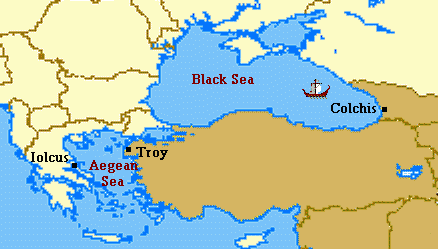
 |
Jason began his voyage from his father's palace in Iolcus, which is known today as Volos. The departure point for visiting Mount Pelion, Volos lies on the northern shores of the Pagasitikos Gulf.
On the map, you can see clearly that although Iolcus was located quite far from the center of Mycenean civilization down in the Peloponnese, it was definitely part of the Greek region. The city of Troy, which is always referred to in Greek literature as a distant city in the exotic east, is much closer to Greece than is Medea's home of Colchis--located in modern Georgia.
Corinth, by the way, is located right on the northern edge of the Peloponnese where it joins the larger landmass. There used to be an isthmus located there (now a canal has been cut through it, so ships can pass through) that kept the Peloponnese from being an enormous island. More info and pictures are available from the Living Travel web site.
Perhaps even more importantly than mere proximity, Greece and Troy had the Aegean Sea in common, and that led to a certain amount of cultural exchange. Troy, "rich in gold," gained much of its wealth from the fact that it stood at the mouth of the Bosporos (Dardanelles). This tiny neck of water was the only access to the route to the mysterious "Axenos," or "inhospitable sea," today's Black Sea. Very few sailors ventured there. During the Bronze Age the risks were great but the potential for gain was remarkable; the pierced heavy stones that Myceanean ships used as anchors are still turned up on a regular basis, the evidence of daring captains who risked too much to reach the lucrative markets east of Troy.
The Black Sea is dark and deep and cold, and extremely dangerous. No one knew how deep it was, nor when a fierce winter storm might blow up. The fierce Scythian tribes were said to sacrifice strangers. Teeming with fish at the top, beneath the surface the Black Sea is mysterious and dead, completely anaerobic.
When the Argo fled back from Colchis to the Danube delta, with the navy
of King Aeetes in pursuit, she was flying over a lifeless gulf nearly half a mile
deep. Had she sunk on the journey, her timbers and the Argonauts themselves would
still be sitting intact on the blue-grey bottom mud, for there is no oxygen in
the water which would allow them to rot. Down there, only metal is consumed. Their
bronze swords and helmets, the studs on their belts and the rings on their fingers,
would have been dissolved away to nothing. As for the Golden Fleece, it would
have lost all the bullion glare that made it worth the voyage from the Pagasaean
Gulf in Greece to Colchis. It would lie there to this day, across the laps of
dead Jason and Medea, but now restored to its old innocence, whiteness and sheepishness.
|
Link on Archaeological Excavations in the Black Sea - University of Pennsylvania